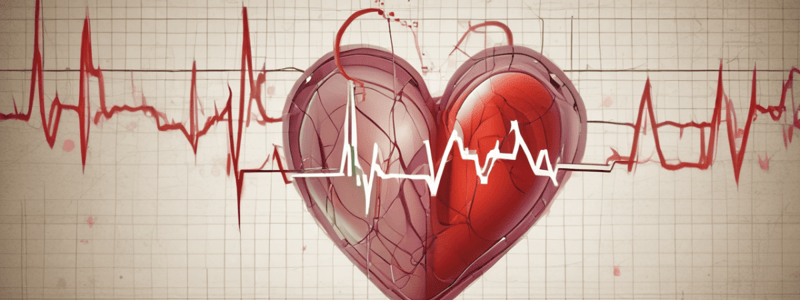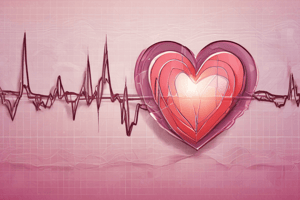Podcast
Questions and Answers
Where are the electrodes placed on the chest to perform an ECG?
Where are the electrodes placed on the chest to perform an ECG?
- On the upper and lower abdomen
- On the left and right shoulders
- Between the fourth and fifth ribs on the left and right side of the sternum (correct)
- On the back and spine
What does the P wave represent in an ECG?
What does the P wave represent in an ECG?
- Repolarization of the ventricle
- Depolarization of the atrium (correct)
- Repolarization of the atrium
- Depolarization of the ventricle
Why is it important to check a patient's sodium levels before an ECG?
Why is it important to check a patient's sodium levels before an ECG?
- Sodium is not important for heart movement
- Sodium levels affect the heart rate
- Sodium levels affect the heart rhythm
- Sodium is an important electrolyte for heart movement (correct)
What can an ECG help identify?
What can an ECG help identify?
Why does the repolarization of the atrium often disappear in the QRS complex?
Why does the repolarization of the atrium often disappear in the QRS complex?
What is the purpose of using gel with ions during an ECG?
What is the purpose of using gel with ions during an ECG?
What is the main purpose of an electrocardiograph?
What is the main purpose of an electrocardiograph?
What is the origin of electricity in the heart?
What is the origin of electricity in the heart?
What is the direction of electricity measured by Lead II?
What is the direction of electricity measured by Lead II?
What is the electrically most important chamber of the heart?
What is the electrically most important chamber of the heart?
Who developed the ECG?
Who developed the ECG?
What symptom may indicate the need for an ECG?
What symptom may indicate the need for an ECG?
How many electrodes are used to measure ECG in hospitals?
How many electrodes are used to measure ECG in hospitals?
What is the mechanically most important chamber of the heart?
What is the mechanically most important chamber of the heart?
What is the primary function of an electroencephalogram (EEG)?
What is the primary function of an electroencephalogram (EEG)?
What type of waves are recorded by an EEG?
What type of waves are recorded by an EEG?
What is the frequency range of delta waves in an EEG?
What is the frequency range of delta waves in an EEG?
Which type of brain wave is typically seen in normal relaxed adults?
Which type of brain wave is typically seen in normal relaxed adults?
What is the purpose of an EEG in medical diagnosis?
What is the purpose of an EEG in medical diagnosis?
What is the frequency range of beta waves in an EEG?
What is the frequency range of beta waves in an EEG?
Where are the electrodes placed to perform an EEG?
Where are the electrodes placed to perform an EEG?
What happens to alpha waves when the eyes are opened or the person is alerted?
What happens to alpha waves when the eyes are opened or the person is alerted?
What is the primary purpose of an Electromyography (EMG)?
What is the primary purpose of an Electromyography (EMG)?
What type of electrodes are inserted into the muscle to be tested?
What type of electrodes are inserted into the muscle to be tested?
What is a common symptom that may indicate the need for an EMG?
What is a common symptom that may indicate the need for an EMG?
What do EMG results typically help diagnose or rule out?
What do EMG results typically help diagnose or rule out?
What is the function of surface electrodes in an EMG test?
What is the function of surface electrodes in an EMG test?
What do motor neurons transmit in an EMG test?
What do motor neurons transmit in an EMG test?
Flashcards are hidden until you start studying
Study Notes
What is Electrocardiograph?
- An Electrocardiogram (ECG) records the electrical signals in the heart.
- It's a common and painless test used to quickly detect heart problems and monitor the heart's health.
Why is ECG done?
- To diagnose many common heart problems, including irregular heart rhythms (arrhythmias), blocked or narrowed arteries in the heart, and previous heart attacks.
- To monitor heart disease treatments, such as pacemakers.
Indications for ECG
- Chest pain
- Dizziness, lightheadedness or confusion
- Heart palpitations
- Rapid pulse
- Shortness of breath
- Weakness, fatigue or a decline in ability to exercise
Heart's Electrical Activity
- The sinoatrial node, located in the right atrium, is the origin of electricity of the heart.
- The electrical activity is sent to the atrioventricular node and then to the purkinjee fibers of the heart.
- Electrically, the most important chamber of the heart is the right atrium.
- Mechanically, the most important chamber of the heart is the left ventricle.
ECG Leads
- Einthoven's triangle has three leads:
- Lead I: direction of electricity from the right arm to the left arm.
- Lead II: direction of electricity from the right arm to the left leg.
- Lead III: direction of electricity from the left arm to the left leg.
- Lead II is important because it directs the electrical pulse from the right atrium to the left ventricle.
Measuring ECG
- Hospitals use 12 electrodes to measure ECG:
- Right arm, left arm, right leg, left leg, and 8 electrodes between the 4th and 5th ribs on the left and right side of the sternum.
- A single electrode is positioned between the 4th intercostal space.
ECG Waves
- P wave: indicates depolarization of the atrium.
- QRS complex: series of waves that indicate depolarization of the ventricle.
- T wave: represents repolarization of the ventricle.
Important to Know
- The repolarization of the atrium is small and will disappear in QRS complex.
- Gel containing ions can be used to increase conductivity during ECG.
- Sodium is an important electrolyte for the heart movement, and checking the patient's electrolyte levels is important.
What do the Results Tell Us?
- Heart rate: ECG can help identify an unusually fast heart rate (tachycardia) or an unusually slow heart rate (bradycardia).
- Heart rhythm: ECG can detect irregular heartbeats (arrhythmias).
- Heart attack: ECG can show evidence of a previous heart attack or one that's currently happening.
- Blood and oxygen supply to the heart: ECG can provide information about this.
- Heart structure changes: ECG can provide clues about an enlarged heart, heart defects, and other heart problems.
What is Electroencephalogram (EEG)?
- An EEG is a test that measures electrical activity in the brain using small metal discs (electrodes) attached to the scalp.
What Does EEG Record?
- The waveforms recorded by EEG reflect the activity of the surface of the brain and brain cortex.
- EEG records electrical impulses of the brain sent via electrodes placed on the head to an amplifier.
Types of Brain Waves
Delta Waves
- Frequency: 3 Hz or below
- Highest in amplitude and slowest waves
- Normal in infants up to one year and in stages 3 and 4 of sleep
Theta Waves
- Frequency: 3.5 to 7.5 Hz
- Classified as "slow" activity
- Normal in children up to 13 years and in sleep, but abnormal in awake adults
Alpha Waves
- Frequency: 7.5 to 13 Hz
- Usually seen in posterior regions of the head on both sides
- Appears when closing the eyes and relaxing, and disappears when opening the eyes or alerting
Beta Waves
- Frequency: 14 Hz and greater
- Classified as "fast" activity
- Seen on both sides in symmetrical distribution, most evident frontally
- Accentuated by sedative-hypnotic
- Regarded as a normal rhythm
- Dominant rhythm in patients who are alert or anxious or have their eyes open
Why is an EEG Performed?
- To check the status of brain-related conditions such as epilepsy.
What is Electromyography?
- Electromyography (EMG) is a diagnostic procedure to assess the health of muscles and motor neurons.
- EMG results can reveal nerve dysfunction, muscle dysfunction, or problems with nerve-to-muscle signal transmission.
How EMG Works
- Motor neurons transmit electrical signals that cause muscles to contract.
- EMG uses tiny devices called electrodes to translate these signals into graphs, sounds, or numerical values.
Why EMG is Done
- Doctors order an EMG if patients show signs or symptoms of nerve or muscle disorders, such as:
- Tingling
- Numbness
- Muscle weakness
- Muscle pain or cramping
- Certain types of limb pain
Types of EMG Electrodes
- There are two major types of electrodes used to measure EMG signals:
- Needle electrodes: approximately 1 mm2 wide, inserted into the muscle to be tested
- Surface electrodes: 0.5–2.5-cm wide, non-invasive, and positioned to detect electrical activity that activates muscle movement
What EMG Results Detect
- EMG results help diagnose or rule out conditions such as:
- Muscle disorders (e.g., muscular dystrophy)
Studying That Suits You
Use AI to generate personalized quizzes and flashcards to suit your learning preferences.





